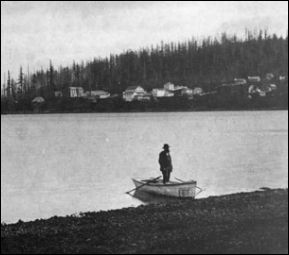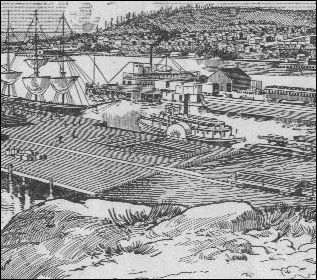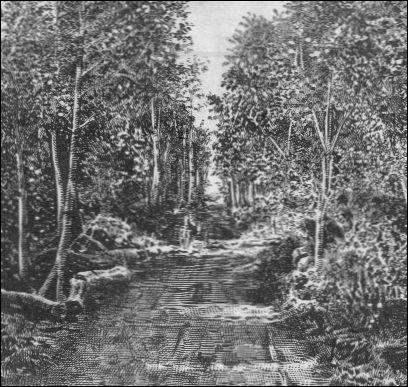| 1826 or 1831 or 1832 | Dan born Southampton, Suffolk County, Long Island, New York by consensus. Other claimed towns: Bridgehampton, Patchogue, Sag Harbor, all nearby, conflict between land affidavits, census and memory of Harris friend, James H. Taylor. We prefer 1832, as does Thacker. |
| @1841-52 sometime | Various sources, with wildly varying timeline, claim Harris shipped out as early as age 15 as sailor at Sag Harbor, New York, sails on whaling ship. China and Japan by 1850, then Hawaii, Alaska and Victoria, B.C. The early years of this range seem exaggerated. |
| 1848 | William "Blanket Bill" Jarman camps out at Whatcom Falls and Squalicum Creek with Indian band, quickly moves on to Olympic Peninsula and future Port Townsend |
| @1850-1851 | According to his brother, George Harris, Dan deserted the ship, Levant, Master Mercator Cooper, while in Hawaii, eventual passage back to Victoria, B.C. |
| 1852 @Oct | William R. Pattle, James Morrison, John Thomas stake claims north to from present Boulevard to about Padden Creek. Union Coal Co. buys northern part, starts village of Unionville |
| 1852 Dec 15 | Henry Roeder and Russell V. Peabody arrive at Whatcom Falls and decide to build mill there |
| 1853 May 23 | Hugh and Teresa Eldridge arrive on the Bay from San Francisco |
| 1853 | Dan settles on what will become Harris Bay, made friends with John Thomas who took donation claim in January 1853 at later-Fairhaven. They built log cabin at future 7th and Harris near Padden Creek |
| 1854 April | Alonzo M. Poe surveys early Whatcom plat containing Eldridge, Roeder and Peabody claims |
| 1854 May | John Thomas dies on claim. First Whatcom settler funeral. Dan finished cabin, lived there |
| 1855 Feb | Maurice O'Connor claims land on the hill east of Thomas/Harris claim. Same year, Dan files for donation land claim on land originally settled by John Thomas; granted in 1868 & 1871. |
| 1855 | Marks the beginning of Dan's legal problems, as sells "spirituous liquor" to Indians, an official no-no in Washington Territory, which is widely practiced. Scrapes continue through 1867 for this offense and smuggling. (See Thacker for details) |
| Mid-late 1850s | Rigged large sloop, traded all inland waterways, unmolested by Indians from Puyallup to Nootka Sound during 55-56 Indian wars. |
| 1858 May | Peak of influx of @10,000 argonauts to what is now Squalicum Flats, camping out on way to Fraser River gold rush in British Columbia |
| 1858 | During Fraser River gold rush he sold whiskey to miners, ferried them on his scow to Victoria |
| 1859 | Indians intercepted, tapped barrel, set him adrift naked, then he spiked barrel, made the same Semiahmoos sick |
| 1859 | When Nooksack Indians launched a raid on the old brick Courthouse in Whatcom in order to release an Indian jailed in connection with a white settler, Dan sailed his sloop to alert Major Granville O. Haller at Fort Townsend, and Major Haller quickly responded with troops on the S.S. Massachusetts gunship |
| 1860 | Dan hosts first area prizefight on the sand spit on his claim. Tom Sheldon, knocked out by unknown |
| 1860 | Dan packs supplies to Cariboo Gold Rush in B.C. |
| 1861 | After 7 years in court, Thomas property sold to Harris "without publication in order to save expenses to the heirs." |
| 1861 | Bought 43 acres from Americus N. Poe from west boundary of Harris at 7th Street out to waterfront (Poe's Point, later known as Deadman's Point) |
| 1861 | Dan made enough to sail to San Francisco, went to Salt Lake City, bought 700 sheep, many died on way to CA, more died on freighter to Sehome, more drown upon arrival here; he traded surviving 22 sheep for cayuses for new pack team |
| 1862 | Sold four acres at Poe's Point to Whatcom County for cemetery, 1888 discovered wrong lots sold
|
| 1867 | Whatcom County Sheriff James Kavanaugh notes in diary that Dan, "a hardened thief," was bailed out of prison by John Davis and Capt. Roeder. And that Sam Brown gave Dan "a beating." (Thacker)
|
| 1870 | Title finally cleared for Poe acreage, which had been included by original owner Alonzo M. Poe in sale in 1858 of 310 acres to Arthur A. Denny |
| 1870 to 1873 | Dan Harris and Harry McCue partners in logging camp at mouth of Padden Creek |
| 1871 | Patent for Thomas land issued to Harris |
| 1871 May 16 | Seattle interests plat Unionville north of Fairhaven |
| 1873 | Michael Padden claims land east of hill in Happy Valley, east to Lake Padden. His land borders O'Connor claim and Padden's future father-in-law, Edward Connelly |
| 1874, Jan. 10 | James Powers's new Bellingham Bay Mail newspaper reported that Dan is preparing to lay out a new town at Harris Bay, mile below Bellingham Bay Coal Co. wharf. If successful, he will build a $50,000 sawmill. (Thacker) |
| 1874 July 4 | Dan's fashion statement; buys stiff white vest to wear over his red undershirt. Seller: Charles Donovan, telegrapher at Bellingham Coal Company store in Sehome who becomes one of his champions. Thacker cites this year as when Dan first envisioned townsite on his claim. And it was also the year his cabin, a "short distance from Sehome," burned to the ground. |
| 1875 | Dan cleared trail alone from Sehome to Lake Whatcom for new Blue Canyon coal mine. (Conflict: Teck on April 25, 1903, cited 1877; Thacker cites 1875 from the actual newspaper citation) |
| 1878 March | Dan pack train with oxen to Cariboo Mining District BC |
| 1878 | Dan Clears Edward Eldridge farm north of Squalicum Creek, paid in cattle |
| 1880 March 6 | Happy Valley neighbor Michael Padden killed by neighbor's child |
| 1880 | Dan drove cattle to Ruby Creek gold rush camp via old Fraser River trail and down Skagit River, returned 100 miles with all but one because miners broke
|
| 1882 March | Peak of new settlers on Bellingham Bay, including Kansas Colony |
| 1883 Jan 2 | Dan platted Fair Haven on Harris Bay |
| 1883 April 24 | Eldridge and Bartlett plat Unionville as Bellingham, north of Fairhaven |
| 1883 June 29 | Dan painted new Fairhaven Hotel (later the Northern) erected at northeast corner of 4th & Harris, leased building to James Weed for 3 years. Weed broke the lease later that year after Dan accused Weed of stealing |
| 1883 | Dan sold $32,000 worth of lots, spent $16,000 on Fairhaven wharf north of his hotel |
| 1883 | Dan sets aside his shipyard reserve as two blocks, between 3rd and 4th streets from McKenzie Avenue to deep water, but aside from his dock, nothing else done |
| 1883 March 4 | On President Cleveland's Inauguration Day, James H. Taylor and local Democrats install largest flag and flagpole in U.S. in stop at east end of Dan's hotel |
| 1884 June 4 | Grand opening for Dan's hotel. Mr. & Mrs. Charles Miller resident managers |
| 1884 | This year marks end of Dan's promotion of lot sales until 1889 (Thacker) |
| 1885 | First Fairhaven boom collapses, Dan loans money for interest income |
| 1885 Jan. 23 | Dan wrote letter to nephew Benjamin Franklin Harris, told him that there are 134 acres in his town site, which were being platted into town lots for sale. He still owned his hotel.
(Journal Ed. note: this letter and the one below from 1889 were discovered by author Thacker, when he conducted extensive research in court records for his Harris publications, the first of which was published in 2007. Thacker then transcribed the letters and waded through Harris's unique grammar and syntax, quite a chore. Dean Kahn, columnist for the Bellingham Herald, published both letters on Dec. 22, 2007, but due to the redesign of the Herald website, the articles are no longer available. Therefore we have scanned Thacker's translation-transcript of each. For this letter, see. We will provide links to the Kahn columns when they are again available.) |
| 1885 March 4 | Dan and James H. Taylor and Democrat friends hoist the biggest flagpole and flag in the U.S. at his hotel |
| 1885 Oct 16 | Daniel Jefferson Harris marries Bertha Wasmer at his Fairhaven Hotel |
| 1886 | Thacker discovered in his research that Mrs. Harris filed for divorce, citing verbal abuse and physical threats |
| 1886-87 Winter | The Harrises winter in Los Angeles for health reasons, buys house on Girard Street |
| 1887 June | Dan comes back to Fairhaven for the summer, returns to Los Angeles in the fall |
| 1888 Spring | Dan returns to Fairhaven for the last time |
| 1888 Summer | Dan sells his land to Nelson Bennett, et al, and the Fairhaven Land Co., 1 piece to Nelson Bennett for $50,000 and another to Charles X. Larrabee for $25,000. When Bennett won't pay for Dan's hotel piano, he abandons it on road to Whatcom |
| 1888 Nov 18 | Bertha died in Los Angeles |
| 1888 Nov 26 | FLC incorporated in Fairhaven |
| 1889 May 11 | Nelson Bennett and FLC files amended plat of Fairhaven; within year adds part of old Morrison and Pattle plats north of town except for old Bellingham property sold in early 1890 |
| 1889 May 16 | Dan wrote letter from Los Angeles to nephew Benjamin Franklin Harris, saying that he was ill. He said he owned property in San Bernardino County, in Clearwater, and on Adams Street, near where Dr. Andrew W. Shorb lived. He said he still owned 25 acres in Fairhaven, which we have not yet verified. (Journal Ed. note: For this letter, see.) |
| 1889 July | Dan returns to Fairhaven to collect balance of his townsite sale proceeds. Leaves in August or September to Los Angeles for last time. Lives in apartment on 413 S. Spring St. |
| 1889 Dec 24 | Bennett and Larrabee's Fairhaven & Southern RR opens between Fairhaven and Old Sedro, two years after Dan subscribed $3,000 to Bellingham Bay Railway and Navigation Co.'s competing rail line. (See this Journal website.) |
| 1889-90 | More than two dozen hotels and boarding houses open in Fairhaven to house the exploding influx of boomers |
| 1890 May-July | Dr. Andrew S. Shorb and wife Martha mysteriously transfer Dan's funds to their name |
| 1890 July | Court later determines that Dan "was not of sound mind" that summer |
| 1890 Aug 18 | Dan dies in Los Angeles "dropsy of the heart" One claim of Aug. 17 |
| 1890 Sep 15 | New Fairhaven Hotel opens at northeast corner of Harris and 12th Street |
| 1890 Fall | Dan's old hotel renamed "Great Northern," apparently because of the Great Northern tracks running a half block away. The lot in 2007 is the site of present Amtrak depot. |
| 1890 Dec 26 | James Wardner's First National Bank opens in new Fairhaven Hotel |
| 1891 Oct | Dan descendants win suit against Dr. Shorb and wife in Los Angeles for bilking Dan of his fortune |
| 1891-2 | Dan's old hotel renamed "Old Fairhaven" |
| 1892 Dec 10 | Nephew Benjamin F. Harris, redeems Harris lots sold at tax sale in 1891 |
| 1893 | Dan's old hotel renamed again to "Northern Hotel", possibly because of the proprietary name of the railroad. Name painted on front of 3rd story, Rates $1.25 day |
| 1893 Summer | Appeal by Dr. Shorb in Los Angeles decided in his favor, reversing funds to be repaid |
| 1894 Feb 10 | Owner of nearby St. Louis Hotel buys the Northern, reopens as boarding house for Chinese laborers |
| 1895 Oct 25 | 5 of Dan's Fairhaven lots valued in 1892 at $23,500 clear probate court, auctioned for $900 cash, result of nationwide Depression |
| 1904 | Dan's old Fairhaven Hotel "fast falling into decay" moved to 5th & Larrabee, demolished in 1910 |
| 1906 | Pacific American Fisheries plants flower garden on old hotel site, "the first factory to inaugurate civic improvement work," according to Rosamonde Van Miert in Settlers, Structures & Ships of Bellingham Bay.
|

 810 Central Ave.,
810 Central Ave., 


